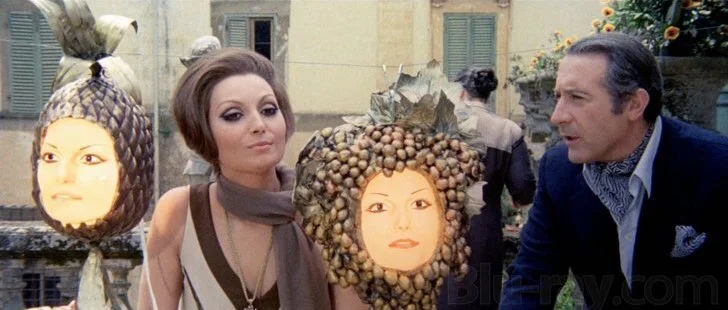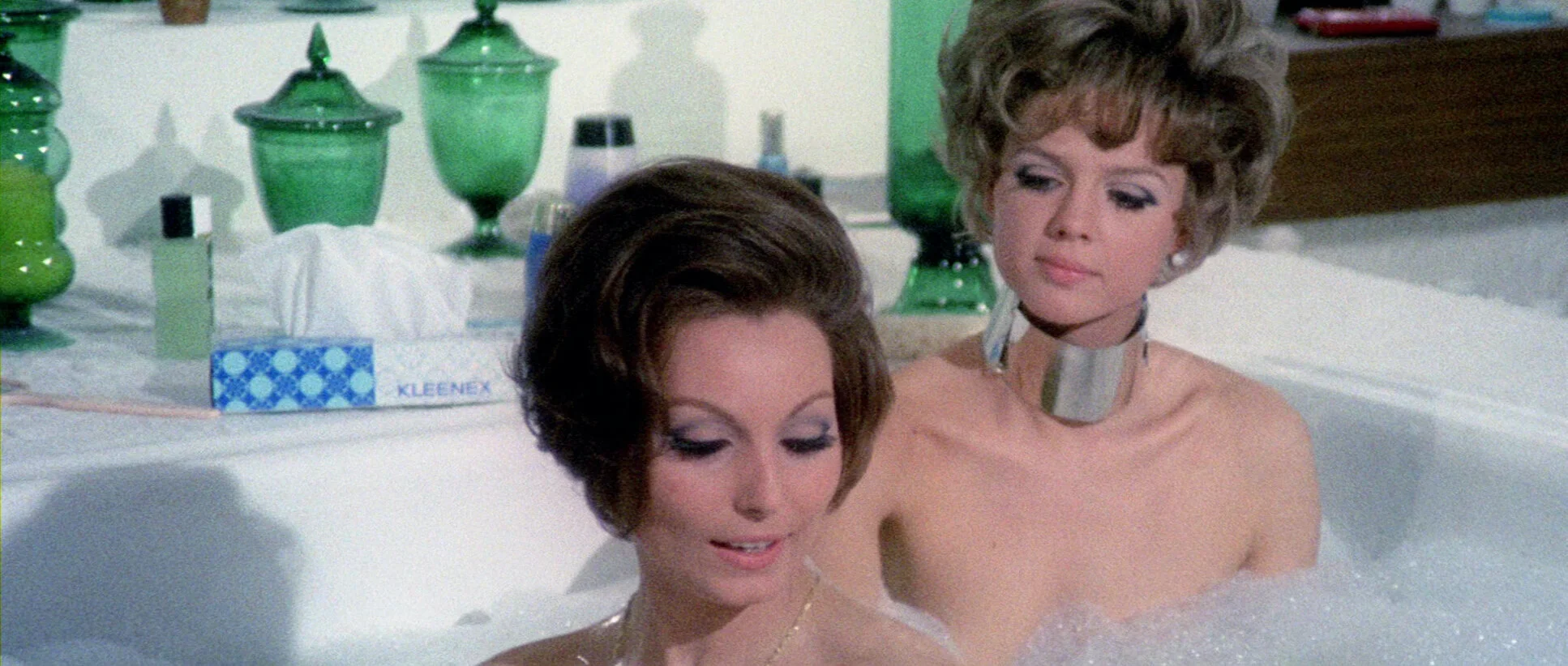CHECK TO THE QUEEN (1969)
Silvia (Haydée Politoff) of CHECK TO THE QUEEN—a.k.a. SCACCO ALLA REGINA, a.k.a. THE SLAVE—is part of film's long lineage of disaffected women. She spends her days lost in elaborate fetishistic fantasy, stifled and bored within the confines of affluent domesticity, recalling BELLE DE JOUR's Séverine. Like the titular character in The Story Of O, Silvia's search for something more forces isolation and a disconnect from her former life. The three fictional women also share the common bond of origins in literary erotica that made a scandalous splash into the cultural mainstream of their respective eras.
Pasquale Festa Campanile's 1969 film adaptation of Renato Ghiotto's novel takes these familiar beats and presents them in a way that feels narratively and aesthetically fresh. The late ‘60s and early ‘70s found the boundaries of cinema becoming more porous, with softcore on the wane, and hardcore not having codified itself as the dominant mode. There was an influx of eroticism and experimentation, and CHECK TO THE QUEEN is a particularly lavish example of the decadent films that flourished in the liminal space of the period.
Left alone while her husband is overseas on business, Silvia turns to work, not out of any actual financial need, but as a panacea for the tedium of her own loneliness. On the advice of a childhood friend, she travels to a remote luxury villa to interview as a secretary for mercurial model and movie star Margaret Mevin (Italian tabloid fixture Rosanna Schiaffano). Margaret isn't looking for typing and shorthand, as much as she is a live in personal assistant to round out the litany of hired help devoted catering to her constant capricious whims.
Rather than be repulsed by Margaret's capacity for imperious command, Silvia immediately ingratiates herself. Finally, there might be someone capable of bringing Silvia's fantasies and reality into something resembling alignment. The chemistry crackles between the two women, the dynamic between them set from the first frame they share together. Silvia's first glimpse of Margaret is as a bystander to her work at a photo shoot. Seen through the lens of the camera, Margaret is a glittering goddess under hot lights, set apart in loving promotional photo close ups from the concerns of mere mortals like Silvia.
The tension of their dynamic pulls both women further and further into their own insular world. While performing an outwardly perfect tabula rasa of submissive obedience, Silvia manipulatively tops from the bottom, purposefully causing chaos so Margaret will institute the harsh punishments and objectification Silvia so craves. Meanwhile, Margaret must reckon with her own detestation that Silvia's devotion drags into the light. Margaret is self aware enough to know that her money holds those around her hostage to her behavior.
The fact that finances are not a deciding factor in her relationship with Silvia forces her to reckon with both her actions and the duality of her own desires. Her dismissal of lesbianism as "disgusting" seems increasingly self-loathing in light of both her personal day to day world of women and her increasingly emotionally intimate ties to Silvia.
CHECK TO THE QUEEN is unusual in its drawing titillation from the tension inherent to BDSM dynamics without immediately sexualizing those interactions or reducing them to a geek show for the vanilla masses. Men and the male gaze don't factor into the narrative in any substantiative way, and the brief appearances of secondary male characters are mainly just to serve as pawns in the chess game between the two women referenced in the English version of the movie title.
Margaret forces Silvia to be her stunt double for a slapping scene in her new film, to hobble about the villa in uncomfortably high heels, and coats her in plaster to serve as a fully nude "living statue" at a garden party.
Silvia then ups the ante on her punishments with creative infractions, like getting caught in bed with one of her Mistress' kept lovers.
There is no central conflict other than the pair's escalating power games.
This would be a detriment in a lesser film, but CHECK TO THE QUEEN is a triumph of opulent aesthetics that makes even its most inert moments delicious to watch. The villa is a modernist dream, all wide open spaces and mod angular furniture. Silvia's fantasy sequences are kaleidoscope swirls of psychedelic color in Super 8, full of luxury bondage gear and elaborate towers of retro futurist wigs.
Margaret swans about between her shoots in kicky leather minis Peggy Lipton would envy. And, while she prefers to keep Silvia in various stages of undress, punctuates that with glittering go-go couture and elaborate costumes befitting a Vegas showgirl as much as the submissive of a wealthy movie star.
Campanile's camera lingers lovingly on Flavio Mogherini's production design, letting the viewer drink in every detail of Margaret's opulent world, from the massive mechanical horse in her bedroom to the delicate assortment of exotic plants in her garden, with Silvia being another acquisition in her copious collection of beautiful things.
The women's faces are often framed in tight close ups and warm light, letting both actresses convey in expression all of the things their characters don't dare to say. The film effectively conveys the world of a woman who replaces the sugar with cocaine at a dinner party for a lark, who rolls about in silk robes on a carpet of 10,000 lira banknotes.
To further the mood of decadence and excess, Piero Piccioni's lush score is a masterpiece of lounge pop and jazzy wandering, the music so undeniable it received wider distribution than the film. If 1973's BABA YAGA is the sequential art of comics come to life, CHECK TO THE QUEEN is the glossy world of ‘60s European fashion editorial rendered in three dimensions.
Only toward the very end of the film do the two women come to more realistic terms. Margaret finally begins showing signs of trust in Silvia's devotion, while Silvia learns the hard way that even objectification by the most skilled of dommes won't eliminate her from the messy reality of her own feelings. They are the one responsibility no one can help her escape.
It was the wrong era to let these characters have the graceful ending their late stage tenderness truly deserves, and the resolution we get seems a last minute cop-out for the censor boards. Something positively dripping with kinky associations and queer desire would never have passed the censors without some unneeded cruelty, some punishment via pathology in the end.
While CHECK TO THE QUEEN's endgame leaves much to be desired, the bulk of the runtime is a sumptuous, sensual delight that allows its characters to enjoy the sort of access to excess indulgence queer characters are rarely afforded. For those who sit outside the accepted parameters of desire and sexuality, the ultimate in luxury can often be finding someone who makes you feel truly and completely seen.
CHECK TO THE QUEEN can be found as a DVD/Blu Ray combo (under the alternate title THE SLAVE) via Amazon.






